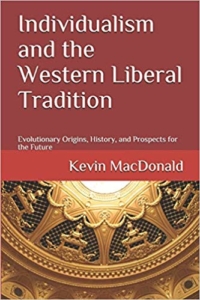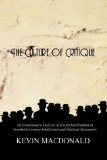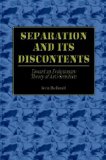It has been suggested that we live in an era of postmodern moral panics — bouts of moral horror directed, inter alia, at contraventions of elite values related to race, racism, and ethnic and gender identity politics. Kenneth Thompson has pointed out the “increasing rapidity in the succession of moral panics” and “the all-pervasive quality of panics that distinguish the current era.” Amplifying and sensationalizing collective anxieties, moral panics become a vehicle for the reassertion of consensual societal values and moral boundaries in a de-traditionalized cultural climate — a climate characterized by the politics of spectacle and simulation, “manufactured uncertainties,” mediatized crises and unprecedented mass migrations of non-Europeans.
In the course of its historical evolution, as Ingolfur Blühdorn has pointed out, democracy seems to be moving away from the theoretical ideal of rule of the people by the people. Throughout the West, mainstream political parties struggle to hold back the tide of growing disillusionment of electorates, reflecting a transnational, post-democratic exhaustion of the emancipatory-progressive project, accompanied by a shift to the politics of simulation.
Postmodernism has, since its inception in the 1960s, been associated with the assumption of a breakdown of the distinction between fact and fiction and the denial of an extra-linguistic reality. The changed conditions of the 1980s, most visible in the debates about race, gender and creed, the practice of multiculturalism, and the fervor of political correctness, have — according to Gerhard Hoffmann and Alfred Hornung — brought about a form of “emancipatory postmodernism,” intensifying the urgency of moral conduct. Moral panic about racism has sometimes been routinized and institutionalized into ongoing, long-lasting campaigns in an attempt to reshape the entire normative, attitudinal, and axiological landscape, leading to the construction of an entirely euphemistic, media-saturated society, expurgated of every sort of “evil.” The final outcome is a hackneyed world of surfaces ,— an era marked by sanitization of language, “hate crime” laws, a post-democratic cult of minorities, and mainstream “anti-Whiteism.”
The Media: Ritualized Manufacture of Moral Virtue
As Nick Couldry points out, ever since information and communication technologies such as television and computers were domesticated – that is, “inserted into lasting positions within everyday routines” – the media have taken their place “alongside other domestic technologies such as central heating systems and the car … the dynamics of family life, education, etc.” Media discourses tend to be highly ritualized, ideological, and fundamentally moral. As Simon Cottle observes, the politics of race and racism have often been refracted and publicly enacted “in dramatic, ritualized and performative ways.”

Performing Anti-Racism
According to Roger Silverstone, the world’s media are “an increasingly significant site for the construction of a moral order.” The mass media are capable of manufacturing consent, enacting and performing conflicts as well as reporting and representing them. Media representations, thus, are not politically innocent or outside the action; the daily infusion of journalism — delivered 24/7 into the fabric of everyday existence via real-time modes of communication — often define the situation influencing public behavior, thus often becoming self-fulfilling prophecies. Simon Cottle observes that “the media rarely contribute to an area of democratic engagement and public deliberation but to a distorted realm of communication in which propaganda and dominant views and values are disseminated largely unopposed.” Media representations do not simply ”reflect” society but can play an active part in constituting what the nature of that society is and in defining what its future may be. As John Fiske notes in his article “Radical shopping in Los Angeles: race, media and the sphere of consumption”:
The term media event is an indication that in a postmodern world we can no longer rely on a stable relationship or clear distinction between a ‘real’ event and its mediated representation. Consequently, we can no longer work with the idea that the ‘real’ is more important, significant, or even ‘true’ than the representation. A media event, then, is not a mere representation of what happened, but it has its own reality, which gathers up into itself the reality of the event that may or may not have preceded it.
The social antagonism at the heart of “media events” and their captivating, sometimes mesmerizing fascination for audiences seem to suggest that media spectacle is becoming one of the organizing principles of the economy, polity, society and everyday life. As Fareed Zakaria observes, the immediacy of the images and the intensity of the twenty-four-hour news cycle combine to produce constant hyperbole: ”Every weather disturbance is ‘the storm of the century.’ Every bomb that explodes is BREAKING NEWS.”

Edvard Munch, The Scream, 1893
The Media: Constructing an “Us versus Them” Climate of Fear
Part of the moral panic induced by the media is that issues are represented as extremes of Good and Evil. Autonomous thought is decapitated by being reduced to a Schmittian concept of the political, gravitating towards friend-enemy dichotomies. As Jean Baudrillard observed, the world of the media is “sworn to extremes, not to equilibrium,” to “radical antagonism, not to reconciliation or synthesis.”
Professor Kevin MacDonald has drawn attention to Jewish aggressiveness,psychological intensity and powerful influence in the media. These qualities and traits — lubricated with the “Puritan moral intensity” of previously dominantintellectual elites in America — may well have inspired or set off a chain reaction leaving a lasting mark on the style and noise level of journalism; e.g. in the widespread journalistic righteousness and hectic aggressiveness, the “prophetic journalism” of passion, polemic, and moral opinion — sometimes resembling the rule-bound sanctimony of the Pharisees. As Doug Underwood has noted:
Many elements of the prophetic tradition — the spirit of righteousness, the indignant moralism, the effort to maintain purity of values, the call for spiritual and ethical renewal, the fierce sense of corruption abounding everywhere — are as typically found in today’s best investigative reporters or crusading editors as they were in the prophetic voices who tried to keep alive Jewish faith and morality during the Israelite empire and the Jewish exile in Babylon. The image of the investigative reporter as the heir of the prophetic tradition is exemplified by I. F. Stone, the son of Russian Jewish immigrants, who spent almost twenty years mining federal government documents for examples of waste and duplicity that he published in his widely circulated newsletter. Described as a ‘cheerfully angry man’, Stone impressed people with his ‘permanent sense of outrage’, as the Washington Post reporter Peter Osnos put it.
Underwood describes the way in which “the prophets of the Bible loom behind the writing that today we would call advocacy or adversarial journalism.” Although the religious overtones may not always be evident in contemporary journalism, the prophecy of moral indignation rings loudly. According to Underwood, the elements of Jewish prophetic expression are most clearly evident in the “journalism of outrage,” as modern investigative journalism has been described. This strong tendency to claim the moral high ground has been one of the key features of Jewish intellectual and political movements, and a hallmark of moral panic:
[Moral panic] is not about pluralism but about virtue. It is not about doing the right thing, but doing the righteous thing. It is not about public policy, but about setting affairs in order. It is about cleansing, rectification. It is about holy war.
The intense ingroup morality of activism makes the population susceptible to vigilant campaigns, endless processes of excommunication and never-ending cycles of censorship initiatives from political claims-makers, moral entrepreneurs and inquisition-style agencies of indoctrination and intimidation. Moral crusades and ‘stigma contests’ are continually launched by the use of highly emotive and rhetorical language, reflecting, as John Fekete observes, “shifting or collapsing boundaries in the meanings, values, codes, and institutions that make up our cultural world.”
[adrotate group=”1″]
In an age of uncertainty, as W. Hollway and T. Jefferson emphasize, “discourses that appear to promise a resolution to ambivalence by producing identifiable victims and blameable villains are likely to figure prominently in the State’s ceaseless attempts to impose social order.” Elite-manufactured panics can help to divert attention from deepening crises — as a response to an “exhaustion” of public consent to a crumbling civilization. While the impact of more short-term panics is usually restricted to reaffirming moral boundaries, a series of panics focused on the same threat over a long period of time can bring about institutional change in the criminal justice system, the education system, politics, etc. The consequences of the contemporary “moral administration” of the public sphere is political correctness, orthodoxy and decorum. As John Fekete points out: “Panic thinking makes panic politics, and panic politics have panic implementation.”
Beginning in January 1989, Professor J. P. Rushton was exposed to years of abuse, and to the threat of job loss and even criminal incarceration after reading a paper at a science symposium in San Francisco: According to John Fekete, Rushton examined social-science data related to social behavior, physical characteristics, and numerous other traits, and concluded that the data clustered in such a way that three different racial groups — Negroids, Caucasoids, and Mongoloids — could be distinguished. He did not claim that his hypotheses about the evolution of races could predict individual variation or that they can serve as the basis for any social, legal, or political policies that would single out members of a racial group for discriminatory treatment. Nevertheless,
on February 2, 1989, David Peterson, former premier of Ontario, denounced Rushton’s work as ‘offensive to the way Ontario thinks’ and demanded that he be fired. Rushton was pilloried in the press, and linked by metaphor with the Nazis, the Ku Klux Klan, and the Anti-Christ. A month later, the Ontario Provincial Police launched a six-month investigation, questioning him and his colleagues, to determine whether he had violated the Criminal Code by promoting “hatred.” The Attorney General of Ontario decided that his scholarship was incompetent but not criminal.[emphasis in original]
Rushton’s department ordered that he be removed from direct contact with students, and lecture only by videotape, and that students be permitted to watch the tape only individually, under supervision at a location in the psychology department.
Similar punitive trends and ostracism of non-conforming belief or behavior have also been observed in the campaign against Kevin MacDonald by the $PLC. As Professor MacDonald reports:
Someone not connected to CSULB sent an email to the entire Psychology Department—except me—asking why they allowed an“anti-Semite” to teach there. The result was an uproar, with heated exchanges on the faculty email list, a departmental meeting on what to do about me and my work, and intense meetings of the departmental governing committee. Cold shoulders, forced smiles and hostile stares became a reality. Going into my office to teach my classes and attend committee meetings became an ordeal.
Prof. MacDonald has been listed as one of the “13 worst people in America” and “The scariest academic”. Obviously, the guiding principle of moral panic is: guilty if accused. As Prof. Fekete points out, a zero tolerance strategy is employed “to automate the implementation of its own program”:
Zero tolerance is about enforcement. Often, its proponents pretend to be unaware of the born-again authoritarianism that is concealed behind the moralistic subject matter of zero tolerance. They speak virtue, but they prepare to do vice. Zero tolerance is the dark side of utopian absolutism; it is tyranny militant, even if it views itself only in the mirror of its intentions, and not pragmatically, in the mirror of its actions and their consequences.
A prime example of moral panic is the Matthew Shepard case which led to years of moral angst in the media and pressure by activist groups that ultimately resulted in the passage of expanded “Hate Crime” laws. Numerous songs have been written about the murder, as well as three narrative movies and a documentary. Simon Cottle reports that the Stephen Lawrence case in Britain — principally played out and enacted in the media — led to a “raft of wide-ranging, and consequential, legislative reforms … aimed at, inter alia, changing policing practices, increasing ethnic minority recruitment and instituting social reforms designed to tackle ‘institutional racism’ … within police services as well as over 44.000 separate public institutions throughout British society.”
The ”self-immunizing techniques” used by anti-racist elites and pro-immigration activists in their point-blank refusal of any criticism of the ongoing suicidal project, are often rooted in the stereotypically retold events of World War II, from whose ashes and ruins the gospel of liberal immigration policy emerged – preached, wrapped and marketed as moral penance. In both Europe and America the Holocaust can be seen as a central icon of victimology (often accompanied by a correspondingly antagonistic demonology) and a powerful weapon of the forces advocating — more or less implicitly — the displacement of European-derived peoples.
In accordance with this dualistic Good-versus-Evil Weltanschauung, Hitler, racists and the Holocaust become useful secular mental images of Satan, demons and hell. The world is thus perceived as a stage for a mythic “struggle between two forces … a manifestation of good and evil locked in an archetypal battle that must be re-fought and re-won.” In a society gradually becoming completely operational, euphemistic and “hyperreal,” the symbolic duality of Good and Evil undergoes a fundamental mutation: Good becomes a utilitarian value judgement.
Exorcising Negativity and Manufacturing Positivity
Steve Macek reminds us of the fact that “the deviant, threatening, or troubling objects of a panic are social constructions, produced by particular social agents in particular contexts for specific purposes.” Quite often, the panic is aimed at eradicating from public discourse negative portrayals of Blacks or other groups favored by the postmodern elites. On July 8, 1996, the school board in Lindale,Texas, voted to ban thirty-two books on an advanced placement (AP) reading list because a trustee said the books conflicted with the values of the community. Prominent among the titles banned by the Lindale board was Huckleberry Finn due to the fact that some of the book’s characters use the racial epithets common to the Mississippi Valley thirty years before Emancipation.
This taste for banning all expressions of “heresy” and negativity is widespread. As noted in Banned in the USA,
In July 1996, Superintendent Dr. Claire Brown, Jr., told eighty people at a school board meeting that Huckleberry Finn would be dropped from the required reading list at Upper Dublin (Pennsylvania) High School. Black parents and students had protested the book because the frequent use of the word “nigger” made black children uncomfortable. In February 1997, the Reverend Charles Sims and about twenty members of the African American community in Columbus, Indiana, attended a school board meeting to protest the use of Huckleberry Finn and Tom Sawyer in the local high school’s classrooms. Sims said exposing African American children to the books was “degrading, insensitive, and oppressive.”
In January 1998, the Pennsylvania NAACP added its voice to the debate over Huckleberry Finn by passing a resolution calling on school districts to remove the book from required reading lists, but not school or public libraries, because of its offensive racial language. The NAACP said it would target school districts that insist on having the book read aloud to students.
Baudrillard warned against this kind of “uninterrupted production of positivity” in which only positive statements are allowed: “Whereas negativity engenders crisis and critique, hyperbolic positivity for its part engenders catastrophe, for it is incapable of distilling crisis and criticism in homeopathic doses. Any structure that hunts down, expels or exorcizes its negative elements risks a catastrophe,” says Baudrillard. The utopia of Human Rights “begins in enthusiasm, but when the system truly arrives at the point of the universal, to the point of saturation, it produces a terrible reversion, and all the accidents we’re seeing now, in the form of virulence, which has in a way replaced historical violence.”
Managing Political Discourse: Toward the Soft-Totalitarian State
Baudrillard describes the transpolitical as “the passage from growth to excrescence … from organic equilibria to cancerous metastases.” The paradoxical outcome of the late-modern “trans-political” situation — in which everything becomes political as the political domain loses its boundaries and distinctness — is a depoliticization of society. This is sometimes called the third transformation of democracy (the second triggered the transition from direct city-state democracy to modern, representative nation-state democracy) — a move towards presidentialized leader democracy, in which electorates become merely “re-active” in top-down political processes.
These top-down processes define what the issues are and the limits of legitimate debate. Colin Crouch emphasizes that Western societies “are increasingly moving towards the post-democratic pole” as politics and government “are increasingly slipping back into the control of privileged elites in the manner characteristic of pre-democratic times”:
[In post-democracy] public electoral debate is a tightly controlled spectacle, managed by rival teams of professional experts in the techniques of persuasion, and considering a small range of issues selected by those teams. The mass of citizens plays a passive, quiescent, even apathetic part, responding only to the signals given them. Behind this spectacle of the electoral game, politics is really shaped in private by interaction between elected governments and elites.
The result is that many of the most important issues facing Western countries, such as the wisdom and fairness of massive non-White immigration, are never debated by political candidates or discussed in the mainstream media in a balanced, intellectually honest, rational and informed manner.
Kevin MacDonald has emphasized the genesis of “soft totalitarian” regimes, i.e. regimes “maintained less by brute force than by an unrelenting, enormously sophisticated, and massively effective campaign to contain political and cultural activity within very narrow boundaries.”
The regime is maintained by a consensus that has become part of the furniture of life, repeated endlessly in the major media and reassuringly affirmed by wise-looking professors at prestigious universities. To dissent from this consensus removes one from the mainstream and stigmatizes one as immoral and quite possibly suffering from a psychiatric disorder. … [D]emocracy is identified not with the power of the people to pursue their perceived interests. Rather, government is to be the province of morally and intellectually superior elites who have no commitment to the ethnic interests of the European majority; and in an Orwellian turn, democracy is defined as guaranteeing that majorities will not resist the expansion of power of minorities even if that means a decline in their own power.
The aim of this totalitarian tendency, says Zygmunt Bauman, “is not so much to stop individuals from thinking — since that would be impossible even by the most fanatical of standards; but to make that thinking impotent, irrelevant and of no consequence for the success or failure of power.” Giorgio Agamben has noted that “the declaration of the state of exception has gradually been replaced by an unprecedented generalization of the paradigm of security as the normal technique of government.” Global risks produce authoritarian “failed states” — even in the West, as the state structure in what Ulrich Beck has termed “world risk society” bear signs of post-democratic authoritarianism. In the 1990s, Heribert Prantl observed a “new policy of a strong state”:
Politics is in the process of developing a new state. In the security state of the year 2000, the point will no longer be to prosecute crimes and prevent concrete dangers, but instead to avoid even conceivable risks. In this state, therefore, every individual citizen will be viewed and treated as a risk factor. Such a state, which conceives of itself as a risk-avoidance organization, will permit fewer and fewer freedoms to the people. … The people in such a state will at first believe they are in a well-patrolled holiday resort, and will not notice until it is too late that this is a posh prison.
As Beck points out, risk society is a catastrophic society — characterized by a stream of emergencies — in which fear “determines the attitude towards life”:
Security is displacing freedom and equality from the highest position on the scale of values. The result is a tightening of laws, a seemingly rational ‘totalitarianism of defence against threats’. The ‘fear business’ will profit from the general loss of nerve. The suspicious and suspect citizen must be grateful when he is scanned, photographed, searched and interrogated ‘for his own safety’. Security is becoming a profitable public and private sector consumer good like water and electricity.
The Media: Producing Generalized Fear and Anxiety
Brian Massumi has emphasized low-level fear — “naturalized fear … the discomfiting affective Muzak” — as the organizing concept or trademark of contemporary America. The “cancer of fear has taken over,” according to William Upski Wimsatt: “We have government by fear. We have a fear economy. We have a landscape of fear. We have a mass media that sells it.” As the columnist Martin Jacques, noted in The Guardian over a decade ago:
Far from living in less moral times, we now live in a more demanding moral climate. When I was a boy in the fifties, child abuse, the sexual division of labour, violence against women, paedophilia and environmental awareness, to name but a few, were undiscussed and largely unrecognised. Our moral repertoire has expanded enormously.
What we are dealing with in the everyday, mediatized techno-cinema world is the “game of affect-by-design”, or, in Jamie “Skye” Bianco’s words, reality-by-design: “Technoscience and new mediated digital ecologies make futures without loyalty to any past(s), all while charging themselves on the affects of histories.”
The shaping of perception becomes a shaping of reality. As Prof. Fekete observes, panic shapes “an anxiety-ridden world of meanings and values. …Anxiety information today travels at electronic speeds — what Marshall McLuhan once called the speed of angels — and creates instantaneous communication and community. A community of electronic panic: our special gift to the millennium.” As summarized by Elayne Rapping, the general mass media message usually fits into a ritualized, formulaic panic design:
The world is out of control; we are at the mercy of irrational forces, of deranged, sex- and drug-crazed criminals, of heroes and leaders who are degenerate, corrupt, and powerless against their own inner demons and outer temptations — Call the police!
Next: Signs of the Times, Part II: Post-Democracy in the Age of Simulation
E. R. E. Knutsson (email him) is a freelance writer.






















